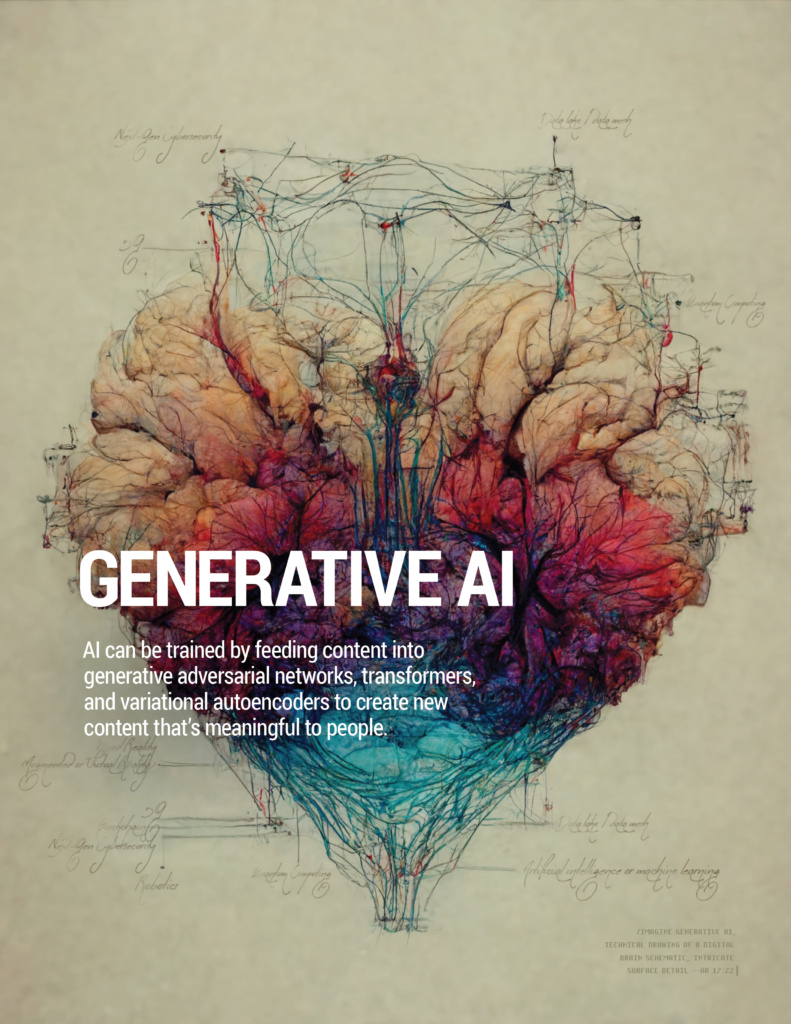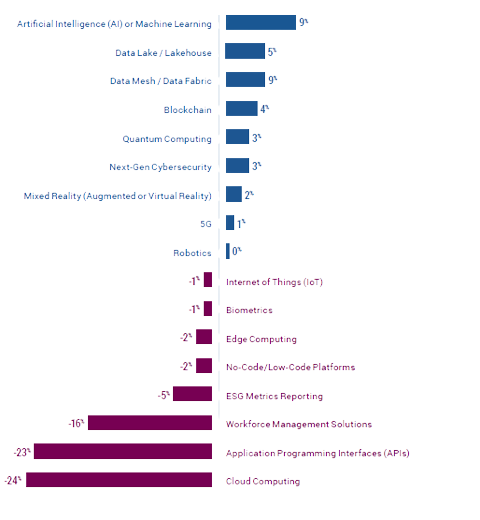
Generative AI is a type of semi-supervised
machine learning that uses neural networks
to create new content or interpret
complex signal information. By training the
models with a large amount of content, they
can be made to generate new works like what
people would create.
The uses for generative AI go beyond creating
imagery. It could help businesses with predictive
maintenance or improving cybersecurity
analytics. It could help generate new ideas
for drugs or assist in quality analysis and
medical diagnoses.
AI is picking up steam with more organizations
adopting it in 2023. According to our survey, AI
will receive the most net-new investment by
organizations by the end of 2023. While 35% of
organizations say they have already invested
in it, 44% of organizations say they plan to invest
in it next year. With a 9% change between
committed investment and planned investment,
AI leads all technologies, followed by
data lake at 5% and data mesh at 5%.
THE CHANGE BETWEEN ORGANIZATIONS THAT
ARE PLANNING TO INVEST IN AN EMERGING
TECHNOLOGY AND THOSE WHO HAVE ALREADY
INVESTED IN IT.

By the end of 2023, most businesses plan to use AI for business analytics or intelligence, with 65% saying they will do so. Also, 63% of businesses say they will use AI to automate repetitive and low-level tasks. Other uses feature a clear drop-off after that, but the next-most popular use for AI is to identify risks and improve security.

BY THE END OF 2023, WHICH OF THE
FOLLOWING TASKS WILL INVOLVE AI
AT YOUR ORGANIZATION?

Generative AI can play a role in enhancing each of the top three use cases of AI. Many businesses struggle with making use of unstructured data for analysis. Generative AI can interpret that data and transform it into structured data. That not only renders it usable in analytics but trainable for robotic process automation (RPA). Generative AI can also detect anomalies in network and application behavior, aiding security systems in identifying threats.
We also asked what AI governance steps organizations have in place today. New legislation in various jurisdictions, including Canada and Europe, are defining new rules around when and how AI can be applied. Organizations that are using AI in situations that governments determine to be high risk will be required to do more to mitigate risks. Yet today, 55% of organizations are doing nothing to govern AI. As more organizations invest in AI and start applying it to more decision-making processes, IT leaders should be putting governance structures in place before they’re made to do so by new regulations.
/DRIVERS
Data needs to be collected and synthesized

THE NEED TO MANAGE UNSTRUCTURED DATA
In the age of data collection in hope of becoming
more data-driven in their processes, organizations
are grappling with how to manage unstructured
data. Unstructured data is the majority
of data collected, describing everything from
written communications to images to presentation
decks. Basically, everything that’s not in
a database or spreadsheet. Without AI to make
sense of it, businesses can’t search this information
and turn it into actionable insights.

NOT ENOUGH DATA
In some areas of business, the problem is a
lack of the specific data they need to train an
algorithm. The medical field often faces this
problem because of the sensitivity of patient
data. One solution to this problem is to create
synthetic data: data that is generated by AI
that closely approximates a real example of
that data. Synthetic data is being used today
to train various AI algorithms, from models
that will detect brain tumors on an MRI scan
to self-driving cars.

DESIRE TO COMPETE
Organizations are increasing their spending
on AI because of the potential benefits it offers.
It can augment workers to do more work more
quickly, reducing costs by automating away
more tasks. It can help discover new products
more quickly and increase revenues. With
more commercialized options available to deploy
generative AI and more organizations investing,
those that don’t invest may fall behind.
Contact us to know more


